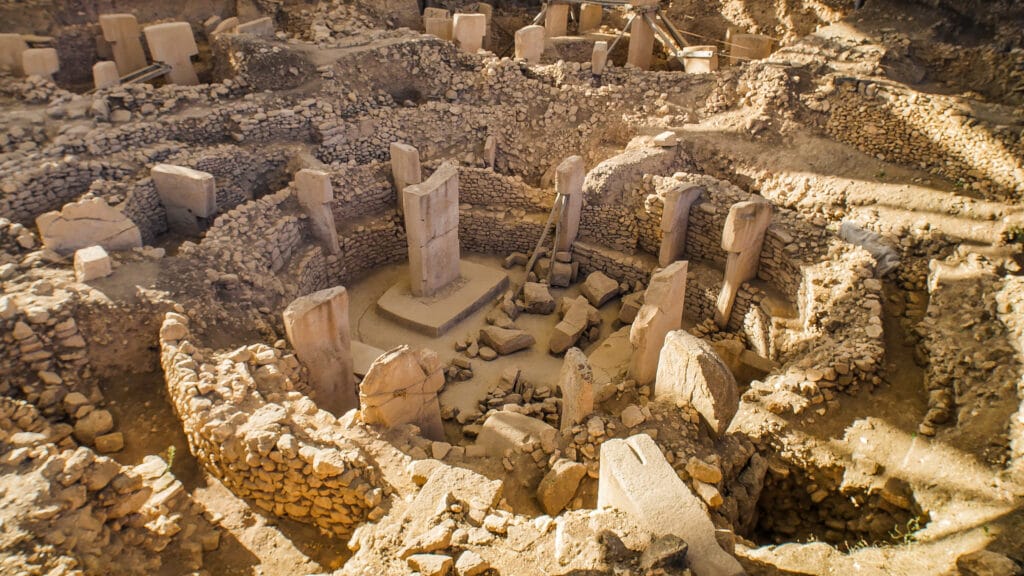For millennia we have been enamored by the mega projects of the past. The great wall of china, the pyramids of Giza and Chichén Itzá have led archeologists on life-long journeys of discovery. Until recently Stonehenge was regarded as the oldest megalithic structure in the world. However, when Göbekli Tepe was unearthed our perceptions of human history were challenged.
Traditional thought outlines the dawn of civilization from nomad groups to city builders over the course of thousands of years. Humankind began in hunter-gatherer societies travelling around vast stretches of land gathering edible plants and hunting for food. Eventually, these early people groups branched out into small agricultural communities. From there modern civilization was born. The most successful of these early civilizations built impressive structures for social or religious use.
In 1963 the oldest megalithic structure was discovered, however it would not be studied for approximately 30 years. Originally archeologists believed the structure discovered at Göbekli Tepe was cemetery from the Byzantine era. It wasn’t until researchers began to dig into the earth below that the scope and exact age of the site was made clear. Clearly, this archeological site was the oldest standing structure on earth.

What is Göbekli Tepe?
The site located in the Southeastern Anatolia Region of modern day Turkey is known as Göbekli Tepe. The entertaining phrase translates to “Potbelly Hill” due to is uncanny resemblance to a refined beer belly. The structure is roughly 1,000 feet in diameter and is made up of more than 200 pillars standing at up to 20 feet tall forming an estimated 20 circles, similar to that of the famous Stonehenge. This circular structure, however, predates Stonehenge by an estimated 8000 years. You read that right, eight thousand years.
A Note on the Unimaginable Age of Göbekli Tepe
Those who built Stonehenge might have thought of Göbekli Tepe in a similar way that we consider Stonehenge today. Yet, the time scale is still not entirely accurate as the amount of time between the two groups endeavors is equal to the time span between Stonehenge’s construction and today… Twice. Another way to grasp the age of Göbekli Tepe is to consider the time span between the Great Pyramid of Giza and the modern era. All of written history between the Egyptian great dynasties and today could have happened three times over since the completion of Göbekli Tepe. This megalithic site is ancient beyond comprehension.
The Findings at the Archeological Site
Archeologists have discovered a curious set of information at the site of Göbekli Tepe. The ancient builders placed T-shaped stone pillars into slots cut out of the bedrock. The large pillars weighed upwards of 10 tons. Many of the pillars featured carvings ranging from rudimentary etchings to sophisticated sculptures. Archeologists discovered many items within the structure including limestone fragments, stone precursors to pottery, stone tools and animal and human bones. It was clear that the site bore some kind of social or religious importance.
There was no clear sign of residence at Göbekli Tepe both in the site itself and in the surrounding area. Domesticated plants and animals were not present at the site. The lack of any domesticated food sources leads researchers to conclude that no residences were present at Göbekli Tepe. It is likely that the builders of the site were a nomadic people group. These people were alive at the dawn of the Neolithic era. Agriculture and civilization was born in the Neolithic era. It is odd for a society that has yet to make the leap into the Neolithic to build such an impressive structure.
The most curious finding at the impressive archaeological site came when digging below the first layer. Göbekli Tepe’s builders built layer by layer over a span of 3000 years. Again to reference the immense age of this structure, Göbekli Tepe was actively under construction for a time span equal to that between today and the Biblical king David of Israel. However, the layers reveal an interesting development of the society that built the megalith.
What Was Going on At Göbekli Tepe?
The newest layers show a sort of technological regression by the later builders at Göbekli Tepe. The deepest layers reveal at the very least a basic understanding of geometry, advanced stone working knowledge, significant artistic ability, and possible an understanding of the astronomical calendar. Strangely the youngest layers do not bear the same understanding. It is as if the builders of Göbekli Tepe forgot the technique’s of their ancestors over time.
The dig site also reveals a careful effort to bury each layer during the construction process. For some unknown reason, the builders of the ancient site repeatedly buried the previous building to construct on top of it rather than tearing it down or building on a new site. The reason for this is currently unknown, but adds to the long list of intrigue surrounding Göbekli Tepe.
Conclusion
Klaus Schmidt is the leading archeologist at Göbekli Tepe. He theorizes that the site is home to the oldest known temple in existence. The presence of animal bones and the lack of any signs of residence leads Schmidt to postulate that is was a ritual center that worshippers of a long dead unknown religion would travel to the site to partake in feasting and other religious activities.
Many other historians have raised theories on the potential uses of such a site and the occasion for building a project larger than anything known in the world at that time. Archeologists have also attempted to understand who these people were and, most interestingly, why did they technologically regress instead of progress. Learn about all these theories and more interesting facts in this episode of Things I Learned Last Night. Watch the video or listen to the podcast to learn even more!
Sources
Tell us what you think of this content!

